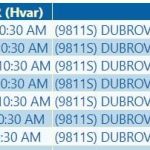All you need to know about driving in Croatia: laws, regulations, motorways, car rental, emergency assistance, alcohol, webcams, and electric charging.
- Driving in Croatia: An introduction
- Driving on Croatian motorways: what you need to know
- Car rental and driving in Croatia
- Where to find current traffic info in English
- Alcohol and driving in Croatia
- Webcams on Croatian roads
- Taking cars on Croatian ferries
- Electric vehicles in the land of Nikola Tesla
- In case of emergency
- Parking in Croatia
- Importing a car to Croatia
Driving in Croatia: An introduction
The roads in Croatia are generally of a high quality, and the introduction of a national motorway network in recent years has greatly improved connectivity and reduced travel times.
Driving is on the right with overtaking on the left. Some of the local driving leaves a lot to be desired, and you should exercise caution when driving in Croatia. That said, it is no more or less dangerous than other parts of Europe.
Seat-belts are compulsory, and the use of mobile phones while driving is banned. The police are quite diligent in enforcement of these, especially during the high tourist season, when there is more traffic in general.
The motorway speed limit is 130 km/h, and it is 90 km/h on national roads, and 50 km/h in urban areas. Stick to the limits, as the Croatian police are often out and about.
Winter tyres and headlights during the day are requirements during winter months, from around November 15 to April 15.
The emergency number of the Croatian Automobile Associations (HAK) is 987.
Croatian motorways: what you need to know
Croatia’s motorways are shiny new and very expensive. And sadly, for the most part, those new sections are rather empty apart from the peak tourist season.
During the main summer months, the motorways are a lot busier, and several bottlenecks appear. The main one is at Sveti Rok tunnel halfway between Split and Zadar, as well as tool booths, particularly at Lučko, which is the entrance from Zagreb to Split, Rijeka and the coast.
During these times, it makes sense to consider taking the old road from Zagreb to Split, which is pretty empty these days, but also very beautiful. This is how I discovered my love of the old road after sitting in traffic for 3 hours on the motorway one recent July.
Toll prices are expensive and are payable in kuna or by credit card. Non-residents may also pay in euro. The price one way from Zagreb to Split is 200 kuna, for example, and the prices are reduced by 10% in winter. To work out the costs of your trip, there is an interactive motorway map and toll calculator.
If you plan to be a regular motorway user, you can apply for the ETC (Electronic Toll Collection) scheme, which has the dual benefit of offering a discount on toll prices, as well as a separate toll booth (the special booth will be marked as ENC). This is usually less busy. The downside is that the service is a prepaid one. To learn more about the ETC system, find out if it is for you.
Car rental and driving in Croatia
As one would expect for a major tourist destination, Croatia has a wide selection of car rental options. Cars can be rented from airports and delivered to hotels, and the concept of one-way rental is commonplace. Tripadvisor offers you an overview of what’s available to rent in Croatia. However, keep in mind that there are smaller rental agencies, especially in smaller places, which can offer you some perks you might find useful.
Some of the more enterprising island car rental companies, for instance, offer one day rentals with collection at the ferry terminal itself. This allows tourists to come and sample the island in one day without the expense and stress of two ferry tickets. To learn more about car rental in Croatia, read the dedicated Total Croatia guide.
Where to find current traffic info in English
You can find the latest road information in English on the HAK website (as well as ferries, trains, and borders).
Additionally, the Croatian Motorways website has a section with the very latest updates.
Additionally, you can download the HAK traffic app, which gives you all the latest information in English, as well as help with roadside assistance. There is also a comprehensive database of 15,000 places of interest (hospitals, pharmacies, national parks etc.) and even a function to help you find your car (I could certainly have done with this in the past).
Alcohol and driving in Croatia
Don’t drink and drive, the law has a zero tolerance policy for drivers under 25 which means that the blood alcohol level (BAC) limit is 0%. The BAC limit for drivers over 25 years old is 0.05% (or 0.5 g/l).
Webcams on Croatian roads
HAK has a good network of webcams all over the country for motorists looking to see the latest situations. These include several locations on each or Croatia’s motorways, ferry terminals, key bridges, national roads, and border crossings. You can see the whole list of webcams, which are all updated regularly, here.
Taking cars on Croatian ferries
Driving to Croatia’s islands is a popular activity, especially in the summer. While the car ferry service generally works well, it is worth bearing in mind a few things.
Firstly, buying a car ticket does NOT guarantee you entry on the the ferry. This is done on a strictly first come, first served basis, and if you want to ensure you make the ferry with your car, you should get there early in peak season.
When ferries get busy in the season, there are often additional ferries in order to reduce the waiting times. But if you do miss your ferry (it is never a problem for foot passengers), you may want to reflect on a practical tip that few think about.
Renting a car at the airport makes a lot of sense. You arrive, pick up your car and the holiday has begun smoothly. BUT…
Island hopping with rental cars
If you are planning to visit the islands, renting a car on the mainland rather than on the island can be a huge negative. Apart from the cost of ferry transportation and chances of missing a crossing due to too many other cars, renting a car once on the island has several other advantages.
If you rent when you arrive, then you will have the car for the duration of your holiday. But often you only need the car a couple of days a week, when you are looking to explore after some days on the beach. Therefore, it can even be more cost effective to rent on an island.
There is another thing to consider if you are planning to island hop. Catamaran connections between islands are generally better than ferry connections (you cannot go by ferry from Hvar to either Korčula or Brač, for example, but you can by catamaran). So if you are stuck with a mainland rental car, you will find yourself in ferry queues to go back to the mainland, in order to go to another island.
Electric vehicles in the land of Nikola Tesla
Croatia is, of course, the birthplace of Nikola Tesla, the genius who perhaps changed the world for the better more than any other. His birthplace in the village of Smiljan now houses a small museum as testament to his life’s work.
A modern-day electric genius in the form of Mate Rimac is continuing the Croatian mantle of electric innovation. Rimac Automobili is producing the fastest electric supercars in the world, this in a country with no other car industry. Sometimes describes as Europe’s Elon Musk, Rimac was featured recently in the Financial Times in a very informative interview.
The electric vehicle revolution is slowly coming to Croatia, and Tesla charging stations are on the increase. One Zagreb couple, Igor and Tina Kolovrat, are responsible for much of the expansion of the electric vehicle story.
At the beginning of 2014, there were just four charging stations and five electric vehicles registered in Croatia. It was then that the Kolovrats decided to organise the first Nikola Tesla EV Rally in Croatia. Known as the ‘quietest rally in the world’, the rally has gone from strength to strength, attracting mostly Tesla drivers from all over the world.
By mid-2018, there were more than 300 charging stations in Croatia, including 8 Tesla super-chargers. The number of the regular chargers kept increasing since, and you can find the map with most of them, regularly updated, on this link. You can check out the Nikola Tesla Rally in the video below, but if you are interested in the electric vehicle story, you may also want to follow the Kolovrats’ website for the latest innovations.
In case of emergency
The emergency HAK roadside assistance number is 987, and the service is generally pretty good.
The general emergency number in Croatia is 112. More information and numbers for emergency in Croatia in the Total Croatia dedicated article.
Parking in Croatia
Parking in Croatia can be a pain, especially in the big cities. But technology is coming to the rescue. One of the best examples of this is the SMS parking service which is now available in most big cities.
Simply dial the number on the parking info sign, enter your number plate, and your payment will be added to your phone bill.
Do be aware, however, that street parking in Zagreb is limited to 2 or 3 hours in the centre. So if you find a spot and think you are there for the day, think again. There are various garages and other parking options where you can freely leave your car, however.
For more information about how and where to park, check out the TCN city parking guides for Zagreb, Split, and Dubrovnik.
Importing a car to Croatia
Cars are relatively expensive in Croatia, and many locals go to countries like Germany and then import. Expats moving to Croatia also want to bring their cars to Croatia. Having been through the painful process of importing a car to Croatia, I can confirm that it is possible. The process of importing a car is something like this.









